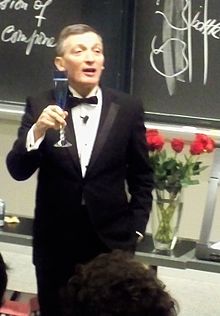- Donald Sadoway
-
Donald Robert Sadoway is the current (as of November, 2008) John F. Elliott Professor of Materials Chemistry at the Massachusetts Institute of Technology. A faculty member in the Department of Materials Science Engineering, he is a noted expert on batteries and has done significant research on how to improve the performance and longevity of portable power sources.[1]
Contents
Background
Born March 7, 1950 in Toronto, Ontario, he did both his undergraduate and graduate studies at the University of Toronto, receiving his PhD in 1977. There he focused his studies on chemical metallurgy.[2] In 1977 he received a NATO postdoctoral fellowship from the National Research Council of Canada and came to MIT to conduct his postdoctoral research under Julian Szekely. Sadoway joined the MIT faculty in 1978.[3]
Research
As a researcher, Sadoway has focused on environmental ways to extract metals from their ores, as well as producing more efficient batteries.[3] His research has often been driven by the desire to reduce the carbon pollution output by various industries.[2] He is the co-inventor of a solid polymer electrolyte. This material, used in his "sLimcell" has the capability of allowing batteries to offer twice as much power per kilogram as is possible in current lithium ion batteries.[4]
In August 2006, a team that he led demonstrated the feasibility of extracting iron from its ore through molten oxide electrolysis. This technique would eliminate the carbon emissions that are generated through traditional methods.[5]
In 2009, Sadoway proposed a liquid metal battery that could be used in stationary energy storage systems.[6] The battery is being funded by ARPA-E.[7]
Teaching
Professor Sadoway teaches 3.091 Introduction to Solid State Chemistry,[8] one of the largest classes at MIT. Sadoway's animated teaching style is popular with students and freshman enrollment in the course has steadily increased while enrollment in 5.111 and 5.112, the other freshman chemistry offerings at MIT, has declined.
In contrast to much of the Institute's learning and teaching technique, Prof. Sadoway demands that students complete one quiz of memorization, which admittedly is a small percentage (<1%) of students' final grades. He requires that students memorize the Periodic table, saying that he would not accept the reality where an MIT student does not know where to find an element on the table. Clever mnemonics are often used to quickly memorize and subsequently forget the table.
Sadoway refers to exams as "celebrations of learning." His weekly tests are returned in no later than twenty-four hours, his recitation instructors are required to grade quickly in order to provide instant feedback.
In the fall of 2007 the number of students registering for 3.091 reached 570 students, over half the freshman class. The largest lecture hall available on campus seats 566 students, enough to amply house the class. Sadoway much prefers teaching in one of the smaller lecture halls, seating only 450; as such the Institute had to take the unprecedented step of streaming digital video of the lecture into an overflow room to accommodate all the students interested in taking the course.[9] In contrast, most classes at MIT are relatively small with approximately 60% of classes at MIT having fewer than 20 students.[10] The popularity of this course has reached outside of the MIT campus as a result of the MIT OpenCourseWare initiative. This is seen in a comment by Bill Gates who told the Seattle Post-Intelligencer "... Everybody should watch chemistry lectures -- they're far better than you think. Don Sadoway, MIT -- best chemistry lessons anywhere. Unbelievable." [11]
Professor Sadoway's lectures often include the history of science, especially with respect to the Nobel Prize. Sadoway gives out "library assignments" in which he asks students to research Nobel Prize winning papers. He begins his lectures by playing music, which has some connection with the lecture's material. He ends his lectures with five minutes of culturally relevant material, such as automotive exhaust processing or his own work on batteries.
References
- ^ David Armstrong (2005-12-26). "Power in Your Hands". Forbes Magazine. http://www.forbes.com/free_forbes/2005/1226/081.html.
- ^ a b "Donald Sadoway Interview". 2002-08-02. http://dibinst.mit.edu/hrst/hrs/materials/public/Sadoway/Sadoway_interview.htm.
- ^ a b "Allen, Sadoway named to chairs". 1999-05-05. http://web.mit.edu/newsoffice/1999/chairs-0505.html.
- ^ Jha, Alok (2005-02-24). "The beauty of bendable batteries". London: The Guardian. http://www.guardian.co.uk/life/feature/story/0,13026,1423451,00.html. Retrieved 2010-05-01.
- ^ Kurt Kleiner. "Electrolysis may one day provide 'green iron'". NewScientist.com. http://www.newscientisttech.com/article/dn9878-electrolysis-may-one-day-provide-green-iron.html.
- ^ Sadoway proposing all-liquid metal battery
- ^ Liquid metal battery funded by ARPA-E
- ^ Johanne Blain-Ruffin. "3.091 Course Homepage". http://web.mit.edu/3.091/www/index.html.
- ^ Valery K. Brobbey. "Overenrolled 3.091 Will Remain In 10-250 But Stream to 26-100". tech.mit.edu. http://tech.mit.edu/V127/N39/3.091.html.
- ^ "MIT Rated 7th in Latest U.S. News Ranking". http://web.mit.edu/fnl/volume/183/usnews.html.
- ^ TODD BISHOP. "Q&A: Gates talks about letting go, the future and the foundation". seattlepi.com. http://www.seattlepi.com/business/368079_gatesqa24ww.html.
- Donald R. Sadoway resume
- Introduction to Solid State Chemistry: Course description, from OCW.Mit.edu
External links
- Don Sadoway Playlist Appearance on WMBR's Dinnertime Sampler radio show October 2, 2002
- Innovation in Energy Storage: What I Learned in 3.091 was All I Needed to Know lecture by Donald R. Sadoway, June 5, 2010
Categories:- Canadian emigrants to the United States
- Materials scientists and engineers
- Massachusetts Institute of Technology faculty
- Living people
- 1950 births
- People from Toronto
- Naturalized citizens of the United States
Wikimedia Foundation. 2010.

